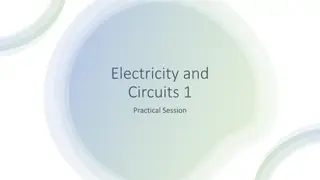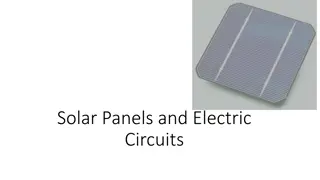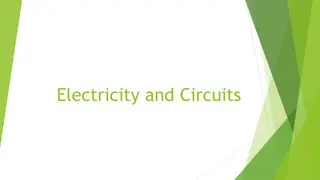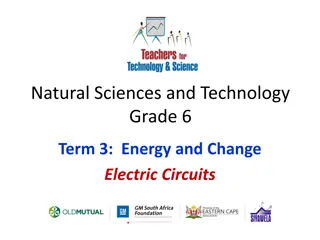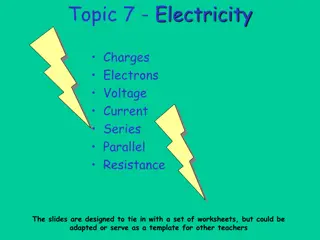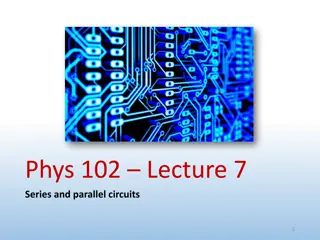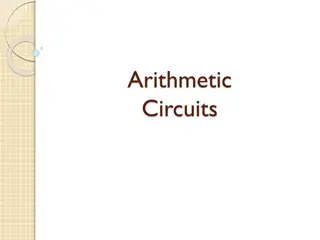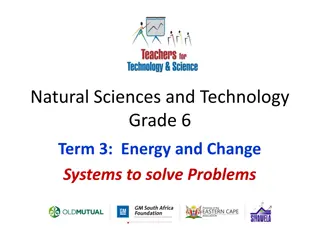Exploring Basic Electricity Concepts Through Simple Circuits
Delve into the fundamentals of electricity with engaging activities like creating simple circuits using paperclips and wires. Understand concepts like electric current, unbalanced charges, and the role of electrons in generating electricity in a fun and interactive way.
Download Presentation

Please find below an Image/Link to download the presentation.
The content on the website is provided AS IS for your information and personal use only. It may not be sold, licensed, or shared on other websites without obtaining consent from the author. Download presentation by click this link. If you encounter any issues during the download, it is possible that the publisher has removed the file from their server.
E N D
Presentation Transcript
ENERGY BASICS MR. CONKEY PHYSICAL SCIENCE/PROJECT RECHARGE UNIT 1 LESSON 1: SIMPLE CIRCUITS
ESSENTIAL QUESTIONS What is electricity? What evidence do we have that electricity exists if we cannot see it? What makes a circuit?
ACTIVITY 1: INQUIRY PAPERCLIP CIRCUIT CHALLENGE How can you get the lightbulb to light using four different methods with only a battery, paperclip, and a lightbulb? Draw diagrams with labels of each of the different methods you come up with. Did you figure it out? Show me!
ELECTRICITY Electricity is a result of charged subatomic particles Electrons = negatively charged particles Orbit the nucleus of atoms Protons = positively charged particles One of the major building blocks of an atoms nucleus
UNBALANCED CHARGES An atoms charges are usually balanced (equal #s of protons & electrons) Energy is available when charges are not balanced One form of potential energy is static electricity Charges are separated and are not moving to regain balance
ELECTRIC CURRENT Electric current the movement of electrons (e ) from a place of an electric excess to one of an electric deficit In the previous activity the D-cell battery was the source of electric current Inside the battery: chemical reaction causes e s to move from one terminal (end) to the other; when the chemical reaction stops the battery is dead Borrowed from Project Recharge (Envirolution)
ACTIVITY 2 : LIGHTING THE BULB WITH WIRES How will you change your set up in order to light the bulb with two wires instead of a paperclip? Is there more than one way to achieve this? When you have successfully completed the activity, draw a diagram of your set up and label it!
ACTIVITY 2 : POST QUESTIONS Where did you connect the wires to the battery? Where did you connect the wires to the light bulb? What happens when you touch the wire to the glass part of the bulb and why?
ELECTRICITY RECEIVER Anything that uses electricity to do something is an electricity receiver The lightbulb produces light when it receives electricity as e s flow through the whole circuit
CIRCUITS AND CIRCUIT TYPES Circuit the pathway through which the electricity flows from the D-cell to the light and back The circuit must form a complete circle from one end of the D-cell to the other in order for electricity to flow The individual parts of the circuit are called components Current flows from the negative end of the battery through the circuit, and then to the positive end.
SCHEMATIC DRAWINGS OF CIRCUITS Schematic diagrams drawings used by electricians/electrical engineers to record their circuits They use symbols that are easy to draw for the components Check these out!
ACTIVITY 2 EXTENSION: LIGHTING THE BULB (YES, AGAIN) Can you light a bulb with just one wire and battery? You did it? Great! Show us
BULBS Filament the part of the bulb that makes it light When electricity flows through it, it gets so hot that it gives off light
ACTIVITY 3: CLOSING AND OPENING CIRCUITS WITH SWITCHES 1 2 3 You will need two bulb holders, one cell holder, and one circuit base Figure out how to use what you have been given to create a circuit where you do NOT have to hold it together Next, study the bulb circuit carefully (i.e. electricity through the wires, bulb holder, and the filament)
CIRCUITS AND SWITCHES What does a switch do to a circuit? You will need one switch Once you have succeeded, summarize how a switch works
CLOSED AND OPEN CIRCUITS Closed circuit a circuit where the electricity flows freely and the lightbulb lights (when the switch handle is touching the clip) Open circuit a circuit where the electricity cannot flow and the lightbulb does not light (when the handle is not touching the clip)
SIMPLE CIRCUITS QUIZ QUESTIONS (ANSWER ON A SEPARATE SHEET OF PAPER) What components are needed to make a complete circuit? How many wires connect to the battery, and where do they connect to make a complete circuit? How many wires connect to the bulb, and where do they connect to make a complete circuit? How did you get the bulb to light with only one wire? How can you get electricity from a source to a receiver? What does a switch do in a circuit? How do people use schematic drawings?




